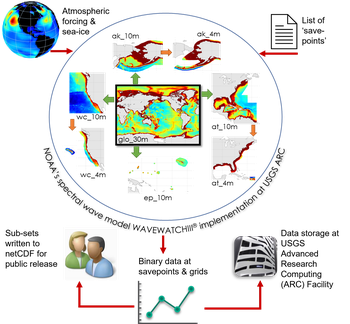Ocean wave time-series data simulated with a global-scale numerical wave model under the influence of projected CMIP6 wind and sea ice fields
By Li H. Erikson, Liv M. Herdman, Chris Flanary, Anita C. Engelstad, Prasad Pusuluri, Patrick L. Barnard, Curt D. Storlazzi, Michael W. Beck, Borja G. Reguero, and Kai A. Parker
https://doi.org/10.5066/P9KR0RFM
Dates
Published: July 7, 2022
Summary
This dataset contains projected hourly time-series data of waves at distinct points along all open U.S. coasts for years 2020-2050. The ‘projections’ (estimates of long-term future conditions) were developed by running the National Oceanic and Atmospheric Administration’s (NOAA) WAVEWATCHIII wave model forced with winds and sea ice cover from seven separate high-resolution Global Climate / General Circulation Models (GCMs) from the 6th Coupled Model Intercomparison Project (CMIP6).
Wave Data
-
Ocean wave time-series data along the U.S. West Coast and surrounding Hawai’i simulated with a global-scale numerical wave model under the influence of CMIP6 wind and sea ice fields
This dataset presents projected hourly time-series of wave heights, wave periods, incident wave directions, and directional spreading at distinct points along the U.S. West Coast and surrounding Hawai’i for the years 2020 through 2050. The projections were developed by running the National Oceanic and Atmospheric Administration’s (NOAA’s) WAVEWATCHIII model. Wind and sea-ice fields from seven different Global Climate or General Circulation Models from the CMIP6 High-Resolution Model Intercomparison Project were used to simulate waves across the globe at a 0.5-degree resolution (approximately 50 km, depending on latitude) and further downscaled to 10- (approximately 18 km) and 4-arc-minute (approximately 7 km) model grids. Point model output data extracted from NOAA’s 4 arc-minute grid for the U.S. West Coast and Hawai’i (wc_4m) are provided herein.
Data Files
WavePnts_CMCC_wc_4m_Fut.nc - 3.7 GB
WavePnts_CNRM_wc_4m_Fut.nc - 3.7 GB
WavePnts_ECEarth_wc_4m_Fut.nc - 3.7 GB
WavePnts_GFDL_wc_4m_Fut_LimitedUse.nc - 3.7 GB
WavePnts_HadGemHH_wc_4m_Fut.nc - 3.7 GB
WavePnts_HadGemHM_wc_4m_Fut.nc - 3.6 GB
WavePnts_HadGemSST_wc_4m_Fut.nc - 3.7 GB
Metadata Files
WavePnts_metadata_wc_4m.xml - 55.9 KB
WavePnts_metadata_wc_4m.txt - 54.6 KB
-
Ocean wave time-series data along the Alaska coast simulated with a global-scale numerical wave model under the influence of CMIP6 wind and sea ice fields
This dataset presents projected hourly time-series of wave heights, wave periods, incident wave directions and directional spreading at distinct points along the open coast of Alaska for the years 2020 through 2050. The projections were developed by running the National Oceanic and Atmospheric Administration’s (NOAA’s) WAVEWATCHIII model. Wind and sea ice fields from seven different Global Climate or General Circulation Models from the CMIP6 High-Resolution Model Intercomparison Project were used to simulate waves across the globe at a 0.5-degree resolution (approximately 50 kms, depending on latitude) and further downscaled to 10- (approximately 18 kilometer) and 4-arc-minute (approximately 7 kilometer) model grids. Point model output data extracted from NOAA’s 4-arc-minute grid for Alaska (ak_4m) are provided herein.
Data Files
WavePnts_CMCC_ak_4m_Fut.nc - 8.1 GB
WavePnts_CNRM_ak_4m_Fut.nc - 8.1 GB
WavePnts_ECEarth_ak_4m_Fut.nc - 8.1 GB
WavePnts_GFDL_ak_4m_Fut_LimitedUse.nc - 8.1 GB
WavePnts_HadGemHH_ak_4m_Fut.nc - 8.1 GB
WavePnts_HadGemHM_ak_4m_Fut.nc - 8.0 GB
WavePnts_HadGemSST_ak_4m_Fut.nc - 8.1 GB
Metadata Files
WavePnts_metadata_ak_4m.xml - 56.5 KB
WavePnts_metadata_ak_4m.txt - 55.1 KB
-
Ocean wave time-series data surrounding Hawai’i and U.S. territories in the Pacific Ocean simulated with a global-scale numerical wave model under the influence of CMIP6 wind and sea ice fields
This dataset presents projected hourly time-series of wave heights, wave periods, incident wave directions, and directional spreading at distinct points surrounding Hawai’i and U.S. territories in the Pacific Ocean, for the years 2020 through 2050. The projections were developed by running the National Oceanic and Atmospheric Administration’s (NOAA’s) WAVEWATCHIII model. Wind and sea ice fields from seven different Global Climate or General Circulation Models from the CMIP6 High-Resolution Model Intercomparison Project were used to simulate waves across the globe at a 0.5-degree resolution (approximately 50 kms, depending on latitude) and further downscaled to 10- (approximately 18 kilometer) and 4-arc-minute (approximately 7 kilometer) model grids. Point model output data extracted from NOAA’s 10-arc-minute grid for Hawai’i and U.S. territories in the Pacific Ocean (ep_10m) are provided herein.
Data Files
WavePnts_CMCC_ep_10m_Fut.nc - 616.7 MB
WavePnts_CNRM_ep_10m_Fut.nc - 533.7 MB
WavePnts_ECEarth_ep_10m_Fut.nc - 533.8 MB
WavePnts_GFDL_ep_10m_Fut.nc - 533.7 MB
WavePnts_HadGemHH_ep_10m_Fut.nc - 533.7 MB
WavePnts_HadGemHM_ep_10m_Fut.nc - 531.8 MB
WavePnts_HadGemSST_ep_10m_Fut.nc - 533.7 MB
Metadata Files
WavePnts_metadata_ep_10m.xml - 55.5 KB
WavePnts_metadata_ep_10m.txt - 54.2 KB
-
Ocean wave time-series data along the U.S. Atlantic, Gulf of Mexico, and Puerto Rico coasts simulated with a global-scale numerical wave model under the influence of CMIP6 wind and sea ice fields
This dataset presents projected hourly time-series of wave heights, wave periods, incident wave directions, and directional spreading at distinct points along the U.S. Atlantic, Gulf of Mexico, and Puerto Rico coasts for the years 2020 through 2050. The projections were developed by running the National Oceanic and Atmospheric Administration’s (NOAA’s) WAVEWATCHIII model. Wind and sea ice fields from seven different Global Climate or General Circulation Models from the CMIP6 High-Resolution Model Intercomparison Project were used to simulate waves across the globe at a 0.5-degree resolution (approximately 50 kms, depending on latitude) and further downscaled to 10- (approximately 18 km) and 4-arc-minute (approximately 7 km) model grids. Point model output data extracted from NOAA’s 4-arc-minute grid for the Gulf of Mexico and NW Atlantic (at_4m) are provided herein.
Data Files
WavePnts_CMCC_at_4m_Fut.nc - 6.6 GB
WavePnts_CNRM_at_4m_Fut.nc - 6.6 GB
WavePnts_ECEarth_at_4m_Fut.nc - 6.6 GB
WavePnts_GFDL_at_4m_Fut_LimitedUse.nc - 6.6 GB
WavePnts_HadGemHH_at_4m_Fut.nc - 6.6 GB
WavePnts_HadGemHM_at_4m_Fut.nc - 6.6 GB
WavePnts_HadGemSST_at_4m_Fut.nc - 6.6 GB
Metadata Files
WavePnts_metadata_at_4m.xml - 56.0 KB
WavePnts_metadata_at_4m.txt - 54.7 KB
Suggested Citation
Erikson, L.H., Herdman, L., Flanary, C., Engelstad, A., Pusuluri, P., Barnard, P.L., Storlazzi, C.D., Beck, M., Reguero, B., Parker, K., 2022, Ocean wave time-series data simulated with a global-scale numerical wave model under the influence of projected CMIP6 wind and sea ice fields: U.S. Geological Survey data release, https://doi.org/10.5066/P9KR0RFM.





